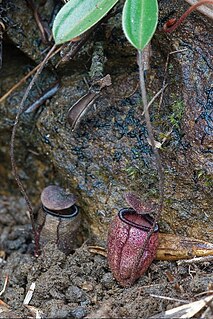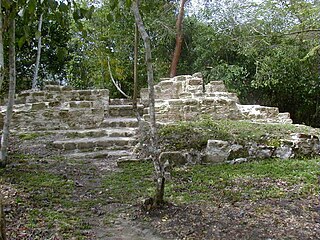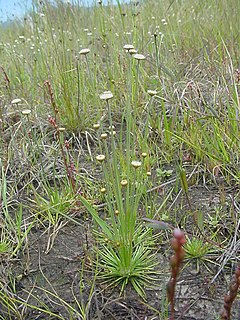Related Research Articles

Ageratum is a genus of 40 to 60 tropical and warm temperate flowering annuals and perennials from the family Asteraceae, tribe Eupatorieae. Most species are native to Central America and Mexico but four are native to the United States.

Rhipidocladum is a genus of New World woody bamboo in the grass family). It found in Mesoamerica, Trinidad, and South America. The genus is characterized by 1) erect, non-pseudopetiolate culm leaves, 2) numerous branchlets arising in an apsidate (fan-like) array, and 3) fruits being true caryopses. The name is derived from the Greek rhipid meaning "fanlike" and clad meaning "branch".
- Rhipidocladum abregoensis - Colombia
- Rhipidocladum ampliflorum - Venezuela
- Rhipidocladum angustiflorum - Colombia, Venezuela
- Rhipidocladum bartlettii - Mexico, Belize, Guatemala, Honduras
- Rhipidocladum clarkiae - Costa Rica
- Rhipidocladum harmonicum - from southern Mexico to Bolivia
- Rhipidocladum martinezii - Mexico (Chiapas)
- Rhipidocladum maxonii - Costa Rica, Guyana
- Rhipidocladum neumannii - Argentina, Bolivia
- Rhipidocladum pacuarense - Nicaragua, Costa Rica
- Rhipidocladum panamense - Panamá
- Rhipidocladum parviflorum - Venezuela, Colombia, Perú, Bolivia, Brazil, Panamá
- Rhipidocladum pittieri - from Mexico (Michoacán) to Panamá
- Rhipidocladum prestoei - Trinidad
- Rhipidocladum racemiflorum - Mexico from Tucumán to Tamaulipas
- Rhipidocladum sibilans - Venezuela, Guyana

Calyptranthes is a genus of flowering plants in the family Myrtaceae. They are known commonly as lidflowers, spicewoods, and mountainbays. There are about 100 species.

Nepenthes argentii is a highland Nepenthes pitcher plant native to Mount Guiting-Guiting on Sibuyan Island in the Philippines. It is possibly the smallest species in the genus and does not appear to have a climbing stage.

El Pilar is an ancient Maya city center located on the Belize-Guatemala border. The site is located 12 kilometres (7.5 mi) north of San Ignacio, Belize and can be accessed through the San Ignacio and Bullet Tree Falls on the Belize River. The name "El Pilar" is Spanish for "watering basin", reflecting the abundance of streams around the site and below its escarpment, which is rare in the Maya area.
Chamguava is a genus of the botanical family Myrtaceae, first described as a genus in 1991. It is native to southern Mexico and Central America.
- Chamguava gentlei(Lundell) Landrum - Chiapas, Belize, Guatemala, Honduras
- Chamguava musarum(Standl. & Steyerm.) Landrum - Guatemala
- Chamguava schippii(Standl.) Landrum - Guerrero, Chiapas, Belize, Guatemala, Panama
Calyptranthes uniflora is a species of plant in the family Myrtaceae. It is endemic to Jamaica.

Neea is a genus of plants in family Nyctaginaceae from the Caribbean region, Central and South America. Members of the genus are commonly called Nia, Neea, or saltwood.
Pouteria belizensis is a species of plant in the family Sapotaceae. It is found in Belize, Guatemala, and Mexico.
Quiina schippii is a species of plant in the family Ochnaceae. It is found in Belize, Honduras, and possibly Guatemala.

Syngonanthus is a genus of plant in family Eriocaulaceae. It is native to tropical Africa and to Latin America.

Vincetoxicum is a genus of plants in the family Apocynaceae. Although the species in Vincetoxicum have sometimes been included in Cynanchum, chemical and molecular evidence shows that Vincetoxicum is more closely related to Tylophora.

After declaring independence in 1981, Belize enacted the Wildlife Protection Act, which is the main source of wildlife law in Belize. Wildlife in Belize is defined as any undomesticated mammal, reptile or bird, amphibian and any egg, nest or part or product thereof. Although Belize is only two hundred miles (320 km) long and a little more than sixty miles (97 km) wide, it hosts a remarkable abundance of flora and fauna. It is the home of more than 150 species of mammals, 549 birds, 150 amphibians and reptiles, nearly 600 species of freshwater and marine fish and 3,408 species of vascular plants.
Dorstenia belizensis is a plant species in the family Moraceae which is native to Belize.

Telanthophora is a genus of Mesoamerican plants in the groundsel tribe within the daisy family.

Cathorops belizensis, the Belize sea catfish, is a species of sea catfish. It is found in mangrove channels in Belize City. Maximum recorded body length is 32 cm.
The Chiquibul Forest Reserve (CFR) lies within Belize's Greater Mayan Mountains. The Forest Reserve lies adjacent to the Belize-Guatemalan border and as such had been the focus of illegal harvesting of Xate by Guatemalan Xateros. The Chiquibul forest reserve consists of 59,822 hectares. The Chiquibul Forest Reserve is bordered to the southwest, east, and south by the Chiquibul National Park, on the northwest edge by the Caracol Archaeological Reserve (CAR), and on the north side by the Mountain Pine Ridge. The Chiquibul Forest Reserve along with the Chiquibul Park and the Caracol Archeological Reserve compose the Chiquibul Forest.
Carex peckii, Peck's sedge, Peck's oak sedge, or white-tinged sedge, is a species of sedge native to Canada and the United States.
References
- Dwyer, J.D. & Spellman, D.L. (1981). A List of Dicotyledoneae of Belize. Rhodora 83 (834): 161-236